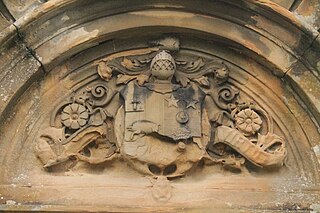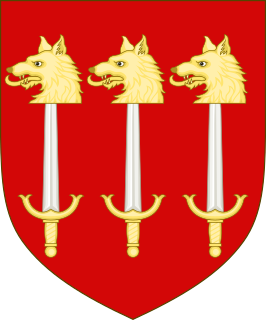Skene baronets, of Curriehill (1628)

- Sir James Skene, 1st Baronet (1579 - 15 October 1633) buried in Greyfriars Kirkyard
- Sir John Skene, 2nd Baronet (died c. 1680)
The Skene Baronetcy, of Curriehill, was a title in the Baronetage of Nova Scotia. It was created on 22 February 1628 for James Skene, Lord Curriehill. He was the son of John Skene, Lord Curriehill, Lord Clerk Register and a Lord of Session under the judicial title Lord Curriehill. The title became dormant on the death of the second Baronet in circa 1680.

Master of the Mint is a title within the Royal Mint given to the most senior person responsible for its operation. It was an important office in the governments of Scotland and England, and later Great Britain, between the 16th and 19th centuries. Until 1699, appointment was usually for life. Its holder occasionally sat in the cabinet.

Lord Napier, of Merchistoun, is a title in the Peerage of Scotland. It was created in 1627 for Sir Archibald Napier, 1st Baronet. Earlier that year, he already held the Napier Baronetcy, of Merchistoun in the County of Midlothian, created in the Baronetage of Nova Scotia. The titles remained united until 1683, when the Baronetcy became dormant. It was revived in the early 19th century and is now held by another branch of the Napier family. Between 1683 and 1686, the Lords of Napier also held the Nicolson Baronetcy, of Carnock in the County of Stirling, and since 1725 the Scott Baronetcy, of Thirlestane in the County of Selkirk, both baronetcies created in the Baronetage of Nova Scotia. The latter one is held till today. Additionally, the tenth Lord was created Baron Ettrick, of Ettrick in the County of Selkirk in the Peerage of the United Kingdom on 16 July 1872.

Earl of Verulam is a title in the Peerage of the United Kingdom. It was created in 1815 for James Grimston, 4th Viscount Grimston. He was made Viscount Grimston at the same time. Verulam had previously represented St Albans in the House of Commons. In 1808 he had also succeeded his maternal cousin as tenth Lord Forrester. He was succeeded by his son, the second Earl.

Earl of Cromartie is a title that has been created twice, both for members of the Mackenzie family. It was first created as Earl of Cromarty in the Peerage of Scotland in 1703 for Sir George Mackenzie, 2nd Baronet, but his titles were forfeited after the Jacobite rising of 1745. It was recreated in 1861 in the Peerage of the United Kingdom for Anne Sutherland-Leveson-Gower, Duchess of Sutherland. Since 1979, the Earl of Cromartie has been chief of Clan Mackenzie.
Baron Moncreiff, of Tulliebole in the County of Kinross, is a title in the Peerage of the United Kingdom. It was created on 9 January 1874 for the lawyer and Liberal politician Sir James Moncreiff, 1st Baronet. He had already been created a Baronet, of Kilduff in the County of Kinross, in the Baronetage of the United Kingdom on 23 May 1871. In 1883 Lord Moncreiff also succeeded his elder brother as 11th Baronet, of Moncreiff in the County of Perth. On his death the titles passed to his eldest son, the second Baron. He was a Judge of the Court of Session from 1888 to 1905 under the title of Lord Wellwood and served as Lord Lieutenant of Kinross-shire between 1901 and 1909. He was succeeded by his younger brother, the third Baron. He was a clergyman. As of 2010 the titles are held by the latter's great-grandson, the sixth Baron, who succeeded his father in 2002.
The office of Lord Clerk Register is the oldest surviving Great Officer of State in Scotland, with origins in the 13th century. It historically had important functions in relation to the maintenance and care of the public records of Scotland. Today these duties are administered by the Keeper of the National Records of Scotland and the Keeper of the Registers of Scotland.
The Bannatyne Club, named in honour of George Bannatyne and his famous anthology of Scots literature the Bannatyne Manuscript, was a text publication society founded by Sir Walter Scott to print rare works of Scottish interest, whether in history, poetry, or general literature. The club was established in 1823 and printed 116 volumes before being dissolved in 1861.
Nineteen baronetcies have been created for persons with the surname Hamilton, eight in the Baronetage of Nova Scotia, one in the Baronetage of England, five in the Baronetage of Ireland, one in the Baronetage of Great Britain and four in the Baronetage of the United Kingdom. As of 2008 two creations are extant, two are dormant, two are either extinct or dormant and twelve extinct.

There have been four baronetcies created for persons with the surname Baird, two in the Baronetage of Nova Scotia and two in the Baronetage of the United Kingdom.

Clan Skene is a Scottish clan.

Sir John Skene, Lord Curriehill (1549–1617) was a Scottish prosecutor, ambassador, and judge. He was involved in the negotiations for the marriage of James VI and Anne of Denmark.
There have been five Baronetcies created for people with the surname Forbes, four in the Baronetage of Nova Scotia and one in the Baronetage of the United Kingdom. The first holder of the Burn Baronetcy of Jessfield, created in the Baronetage of the United Kingdom in 1923, assumed the surname of Forbes-Leith of Fyvie in 1925.
Viscount of Primrose was a title in the Peerage of Scotland. It was created in 1703 for Sir James Primrose, 3rd Baronet, along with the subsidiary title Lord Primrose and Castlefield. He was the grandson of Archibald Primrose, a Lord of Session under the title Lord Carrington, who in 1651 was created a Baronet, of Carrington in the County of Selkirk, in the Baronetage of Nova Scotia. The peerages became extinct on the death of the third Viscount in 1741. However, the baronetcy was passed on to the late Viscount's cousin James Primrose, 2nd Earl of Rosebery, who became the fifth Baronet of Carrington. He was the son of Archibald Primrose, 1st Earl of Rosebery, fourth son of Sir Archibald Primrose, 1st Baronet. For further history of the baronetcy, see the Earl of Rosebery.
There have been three baronetcies created for persons with the surname Foulis, one in the Baronetage of England and two in the Baronetage of Nova Scotia.

The Church of St John the Evangelist is a Scottish Episcopal church in the centre of Edinburgh, Scotland. It is sited at the west end of Princes Street at its junction with Lothian Road, and is protected as a category A listed building.

Greyfriars Kirkyard is the graveyard surrounding Greyfriars Kirk in Edinburgh, Scotland. It is located at the southern edge of the Old Town, adjacent to George Heriot's School. Burials have been taking place since the late 16th century, and a number of notable Edinburgh residents are interred at Greyfriars. The Kirkyard is operated by City of Edinburgh Council in liaison with a charitable trust, which is linked to but separate from the church. The Kirkyard and its monuments are protected as a category A listed building.

Earl Tylney, of Castlemaine in the County of Kerry, was a title in the Peerage of Ireland. It was created on 11 June 1731 for Richard Child, 1st Viscount Castlemaine. The Child family descended from the merchant, economist and colonial administrator Josiah Child, who on 16 July 1678 was created a baronet, of Wanstead in the County of Essex, in the Baronetage of England. The first Baronet was succeeded by his son from his second marriage, Sir Josiah Child, 2nd Baronet.
Skene is a surname of Scottish origin. Notable people with the surname include:
Alexander Hay, Lord Fosterseat (c.1560–1640) was a 16th/17th century Scottish judge and Senator of the College of Justice.
Sir James Skene, Lord Curriehill (1578–1633) was a 17th-century Scottish judge and Senator of the College of Justice.